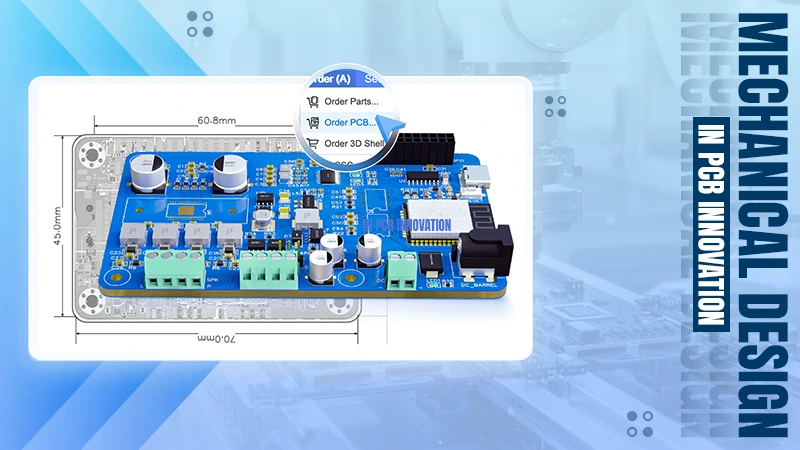From Concept to Reality: How Mechanical Design Drives PCB Innovation

As with most of the electronics scene today, printed circuit board (PCB) design has become a delicate balance of form vs. function. With technology advancing so much, the demand for professional PCB design services in the US is increasing tremendously. This increase reflects the growing complexity of electronic devices and the essential role mechanical design plays in propelling PCB innovation forward.
Evolution of PCB Design: Where Mechanics and Electronics Meet
Understanding the underlying link between mechanical and electrical engineering is the first step in taking a PCB design from concept to reality. Advanced design methods have transformed how we approach PCB development, resulting in a seamless integration of these two disciplines.
Nevertheless in today competive PCB design market in USA manufacturers and designer are trying to strech borders in what is possible and the time of highest quality and reliability.
With the increased size, power, and complexity of devices, the mechanical considerations on PCB design become ever more important. Mechanical issues including thermal management, vibration resistance, and space limits must be considered in modern PCB design services while maintianing maximum electrical performance.
The Function of Mechanical Design in Modern PCB Development
Mechanical design is the cornerstone for effective PCB implementations. When looking for PCB design services, organizations must evaluate how mechanical factors affect all aspects of the board’s functionality. This comprises everything from component location to layer stacking, as well as thermal and production restrictions.
The mechanical aspects of PCB design begin with the physical arrangement of components. Advanced design solutions now include extensive 3D modeling capabilities, allowing designers to see how components will fit inside the specified enclosure and identify potential interference concerns before manufacturing begins. This approach has proven particularly useful in the competitive PCB design industry in the United States, where rapid prototyping and first-pass success are critical.
Thermal Management: A Critical Mechanical Consideration.
Thermal management is a significant difficulty in PCB design. As components get more powerful and densely packed, the necessity for efficient heat dissipation increases. To ensure dependable functioning in a variety of situations, PCB design services must include advanced thermal analysis tools and procedures.
Modern advanced design solutions are designed with the inclusion of thermal simulation capabilities that allow designers to identify potential hotspots and arrange components for greater heat dispersion. In the United States where high-performance electronics need to reliably operate in a variety of environments; this incorporation of thermal analysis into the design process has become commonplace in KB design.
Mechanical constraints and component placement
The physical placement of components on a PCB necessitates careful consideration of mechanical constraints. PCB design services must consider component height constraints, keep-out zones, and mechanical mounting points. This is especially hard in designs when space is limited, such as mobile devices or wearable technology.
Advanced design solutions have evolved to meet these problems by providing complex component placement tools that take into account both electrical and mechanical needs. These tools assist designers in optimizing board layout while guaranteeing compliance with mechanical criteria, which is an important part of PCB design in the United States where products must fulfill stringent regulatory standards.
Manufacturing Considerations in Mechanical Design.
Finally, the manufacturability of a PCB design is the key factor for its success. Any professional PCB design services need to account for all of the manufacturing restrictions during the design phase to ensure efficient and cost-effective production. This comprises board thickness, copper weight, drill sizes, and assembly specifications.
Modern advanced design solution include design for manufacturing (DFM) checks, which help identify potential manufacturing concerns early in the design process. This proactive strategy has become necessary in PCB design in the United States, where maintaining high manufacturing yields while reducing costs is critical for gaining a competitive advantage.
Impact of Material Selection
Material selection influences both the mechanical and electrical performance of PCBs. When choosing board materials, PCB design services must take thermal expansion, flexibility, and durability into consideration. The materials used on the board can have a considerable impact on its mechanical stability, electrical performance, and overall reliability.
Advanced design solutions now incorporate material libraries and analytical tools to assist designers in selecting the best materials for their unique applications. This has become especially essential in PCB design in the United States, where applications frequently call for specialty materials to match specific performance requirements.
Integrated Mechanical and Electrical Design Tools
The combination of mechanical and electrical design tools has transformed the PCB design process. Modern PCB design services make use of integrated design environments, allowing mechanical and electrical engineers to collaborate seamlessly. This integration has become critical for ensuring that designs meet all mechanical and electrical requirements without exception.
Advanced design solutions now provide unified platforms for real-time collaboration across multiple engineering disciplines. This approach is becoming increasingly important in PCB design in the United States, where complex projects frequently require input from multiple engineering teams working concurrently.
Future Trends in Mechanical PCB Design.
The mechanical design will play an increasingly important role in the PCB development as technology advances. Recent trends in flexible electronics, 3D printed electronics, and integrated cooling solutions have made pcb design in usa become more advanced. To compete in the fast-changing electronics industry, PCB design services need to play catch up.
Of course, even further integration of advanced design solutions (including artificial intelligence and machine learning), will become the dominant trend in future PCB design in the United States, with increasing importance for mechanical and electrical aspects of PCB design.
Conclusion:
PB Design is a journey from concept to reality and these two mechanical and electrical needs must be considered. The demand for sophisticated PCB design services and advanced design solutions will hence grow, as technology is still advancing. To compete in the US PCB design competitive landscape, success depends on the ability to effectively organize and integrate both mechanical design and pcb design service considerations throughout the PCB development process.
At the moment, the future of PCB design is reliant upon the continued development of tools and methodologies that close the gap between electrical and mechanical design. For creating the next generation of electronic devices we shall need to leverage advanced design solutions and continuously look at mechanical considerations. The successful integration of mechanical design principles will continue to facilitate innovation in the PCB design, perhaps for more sophisticated, reliable, and efficient electronic products.












